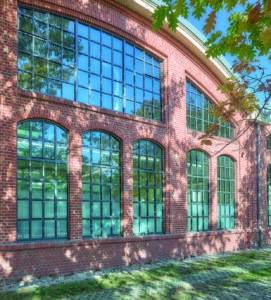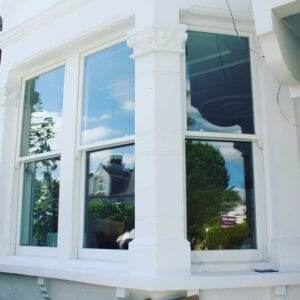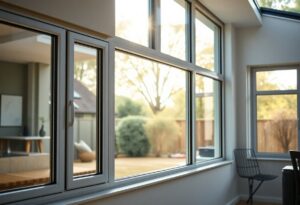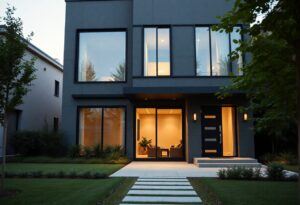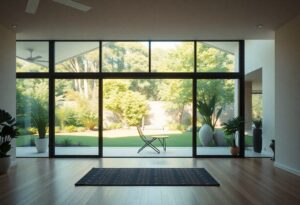Windows play a pivotal role in your home’s energy efficiency and comfort. By understanding Low-E coatings, triple glazing, and other innovative glass technologies, you can make informed decisions that enhance your living space. These advancements not only improve insulation and reduce energy bills but also contribute to a more sustainable environment. Exploring these options allows you to enjoy the benefits of greater sound reduction and UV protection, leading to a healthier and more inviting atmosphere within your home.

Understanding Low-Emissivity (Low-E) Glass
Before you invest in new windows for your home, it’s necessary to understand Low-Emissivity (Low-E) glass. This innovative technology features a microscopically thin coating that reflects heat back inside during winter while keeping it out during summer. By doing so, Low-E windows help maintain a stable indoor temperature, contributing to energy efficiency and reduced heating and cooling costs in your property.
Principles of Low-E Coating
Behind the effectiveness of Low-E glass lies its unique coating. This layer consists of a metal or metallic oxide, which reflects infrared light while allowing visible light to pass through. As a result, Low-E glass not only enhances the comfort of your living spaces but also significantly decreases the amount of ultraviolet (UV) radiation entering your home, protecting your furnishings.
Benefits of Low-E Windows
LowE windows offer a range of advantages, making them a smart choice for any homeowner. By reducing heat transfer, they can lower your energy bills significantly and create a comfortable indoor climate year-round. Investing in Low-E windows also protects your interiors from the damaging effects of UV rays, prolonging the life of your furnishings and decor.
Principles of Low-E windows extend beyond mere thermal performance. They help create an environment within your home that feels more pleasant, maintaining consistent temperatures regardless of the season. Additionally, the energy efficiency of Low-E glass can result in lower carbon emissions, making it a more environmentally friendly option. With the potential for significant savings on energy costs and improved comfort, adopting Low-E technology is a choice you won’t regret.

Exploring Triple Glazing Technology
One of the most effective advancements in window technology is triple glazing, which features three panes of glass instead of the typical two. This innovation enhances thermal performance and sound insulation, making it a popular choice for homeowners seeking optimal comfort. By incorporating inert gases between the panes, triple glazing minimises heat transfer, allowing your home to maintain a consistently pleasant temperature throughout the year.
How Triple Glazing Works
With three layers of glass and gas-filled spaces in between, triple glazing effectively reduces heat loss and improves insulation. This design not only decreases your energy bills but also enhances your home’s acoustics, keeping outside noise to a minimum. The combination of multiple panes, along with low-emissivity (Low-E) coatings, optimises solar gain for better energy efficiency.
Advantages Over Double Glazing
Works like a charm for enhancing your home’s energy efficiency, triple glazing offers significant benefits over traditional double glazing. You’ll experience greater insulation, lower energy bills, and reduced noise pollution, making your living environment much more comfortable.
In addition to superior insulation, triple glazing’s enhanced thermal performance can lead to substantial savings on your heating costs. The three panes create a barrier against heat loss, ensuring your home remains warm during the colder months. Moreover, the extra layer of glass provides a higher level of security and durability, making it harder for intruders to break in. Investing in triple glazing not only boosts your home’s energy efficiency but also adds value and comfort to your living space.
Energy Efficiency and Sustainability
The integration of advanced glass technologies significantly enhances energy efficiency in buildings. Low-E coatings and triple glazing not only minimise heat loss but also optimise natural light, reducing the need for artificial lighting. This combination can lead to lower energy bills and a smaller carbon footprint, aligning with sustainable building practices.
Impact on Energy Consumption
Between the implementation of low-emissivity (Low-E) coatings and the use of triple glazing, residences can witness a dramatic reduction in energy consumption. These innovations contribute actively to maintaining a consistent indoor climate, ultimately minimising reliance on heating and cooling systems.
Environmental Benefits of Advanced Glass Technologies
Efficiency in energy consumption translates directly to a reduction in greenhouse gas emissions. By choosing advanced glazing options, you contribute to global efforts to combat climate change. Additionally, these technologies often utilise materials that are recyclable, further enhancing their sustainability. Below are some key environmental benefits:
- Reduced energy demand from heating and cooling.
- Lower carbon emissions associated with energy consumption.
- Increased utilisation of natural light.
| Benefit | Description |
| Recyclable Materials | Many advanced glass options are made from recyclable materials, promoting a circular economy. |
| Less Resource Intensive | These technologies often require fewer resources to manufacture compared to traditional glazing. |
And as you consider the long-term benefits, it’s vital to understand that the use of advanced glass technologies goes beyond mere aesthetics. They can significantly enhance your home’s energy performance while positively impacting the surrounding environment. Investing in such technologies today can lead to a greener tomorrow. Below are additional environmental advantages:
- Enhanced thermal insulation.
- Minimised reliance on fossil fuels.
- Stimulus for innovation in sustainable building practices.
| Advantage | Description |
| Thermal Efficiency | Advanced glazing provides superior thermal insulation, contributing to reduced energy usage. |
| Innovation Driver | Encourages further advancements in sustainable construction techniques. |
Performance in Various Climates
Keep in mind that the performance of R2 windows varies significantly depending on the climate in which they are installed. Adapting your choice of glass technologies, such as Low-E coatings and triple glazing, can greatly enhance your home’s energy efficiency. Evaluating your local climate will help you make informed decisions that lead to optimal performance and comfort for your living environment.
Effectiveness in Cold Weather
Various studies show that R2 windows, particularly those featuring triple glazing and Low-E coatings, excel in cold weather conditions. By significantly reducing heat loss, these windows contribute to maintaining a comfortable indoor temperature, which proves especially beneficial during harsh winters. The thermal insulation offered by these technologies allows you to enjoy a warm and cosy home while keeping energy bills in check.
Performance in Hot and Humid Conditions
Climates that are hot and humid present unique challenges for window performance. The right glass technologies not only control heat gain but also manage moisture effectively, preventing condensation and potential mould issues. This ensures that your living spaces remain comfortable and healthy during sweltering months.
Considering the demand for high energy efficiency in hot and humid climates, incorporating R2 windows with advanced features like Low-E glazing is highly beneficial. These technologies help in strategically reflecting excess heat while allowing natural light, thus reducing reliance on air conditioning. Furthermore, proper installation enhances ventilation, which can help in regulating indoor humidity levels, leading to a more comfortable living environment and promoting health by minimising mould growth.
Innovations in Glass Technologies
For those looking to enhance their windows, innovations in glass technologies are transforming the industry. You can now access advanced solutions that promote energy efficiency, enhanced aesthetics, and improved comfort in your home. With options such as Low-E glass and modern glazing techniques, you are equipped to make informed decisions that contribute to sustainability and performance in window installations.
Smart Glass Solutions
The rise of smart glass solutions offers exciting opportunities for homeowners. You can now choose windows that adjust their transparency based on sunlight or privacy preferences, enhancing your living environment. These innovative products not only promote energy efficiency but also add an element of luxury and convenience to your home.
Future Trends in Window Technology
Across the window technology landscape, you will notice a shift towards integrating sustainability and smart home features. As a homeowner, this means you can expect increasingly efficient windows designed to reduce your carbon footprint while enhancing your comfort.
Indeed, the future of window technology promises remarkable advancements that will benefit you. Innovations such as self-cleaning glass and photovoltaic windows that generate energy are on the horizon, enabling you to create an eco-friendly living space. Furthermore, with enhanced thermal insulation properties, your home will achieve significant energy savings. You may also encounter windows equipped with IoT capabilities, allowing seamless integration with your smart home devices, keeping you at the forefront of modern living. Embrace these trends for a more energy-efficient and comfortable home environment.
Installation and Maintenance Considerations
After choosing advanced glass technologies, ensuring their successful performance hinges on effective installation and ongoing maintenance. Both factors play a vital role in achieving optimal energy efficiency and lifespan for your windows. Poorly installed or neglected windows can lead to issues such as air leaks or thermal loss, compromising the benefits of your glass technologies. Being proactive about installation methods and maintenance will help you maximise the return on your investment.
Proper Installation Techniques
Installation of Low-E or triple-glazed windows should be performed by professionals to guarantee adherence to best practices. Ensuring precise measurements and using high-quality sealants are crucial for an airtight fit, minimising the risk of future issues. Additionally, proper alignment and handling of materials during installation can significantly enhance the durability and efficiency of your windows.
Maintenance Tips for Longevity
Longevity of your windows can be maintained through proper care and attention to detail. Regularly inspect the seals for any signs of wear and perform a gentle cleaning routine to prevent the build-up of grime.
- Check seals and gaskets for damage
- Keep glass surfaces clean and free of debris
- Inspect frame materials for signs of deterioration
Assume that maintaining these practices will extend the life and effectiveness of your windows.
Even simple actions can significantly enhance the performance of your windows. Engage in routine checks, ensuring you are aware of any structural changes or potential issues.
- Schedule periodic inspections and cleaning
- Apply protective coatings to prevent environmental damage
- Seek professional assistance when needed
Assume that staying proactive will safeguard your investment and ensure that your advanced glass technologies perform efficiently for years to come.
Summing up
Presently, as you consider the advancements in glass technologies such as Low-E coatings and triple glazing for R2 windows, you gain important insights into enhancing energy efficiency and comfort within your space. These innovations not only help reduce heat loss but also minimise glare, making your environment more pleasant and sustainable. By staying informed about these options, you can make educated decisions that improve your property’s overall performance and visual appeal.
FAQ
Q: What is Low-E glass and how does it work in R2 windows?
A: Low-E glass, or low emissivity glass, is a type of glazing that has a microscopically thin coating designed to reflect heat back into the room while allowing light to pass through. In R2 windows, this technology helps maintain consistent indoor temperatures by minimising heat loss during colder months and reducing heat gain in warmer months, ultimately enhancing energy efficiency.
Q: How does triple glazing compare to double glazing in R2 windows?
A: Triple glazing consists of three panes of glass set in a frame, compared to double glazing which has two panes. The extra layer in triple glazing provides superior insulation properties, reducing heat transfer and noise pollution. This makes R2 windows with triple glazing a more energy-efficient and effective choice for those seeking improved comfort and reduced energy bills.
Q: What are the benefits of using R2 windows with advanced glazing technologies?
A: R2 windows incorporating advanced glazing technologies, such as Low-E coatings and triple glazing, offer multiple benefits, including enhanced energy efficiency, reduced heating and cooling costs, improved indoor comfort, and decreased condensation. Additionally, these windows can also contribute to noise reduction and increase the overall aesthetic value of a property.
Q: Are R2 windows with Low-E and triple glazing more expensive?
A: While R2 windows featuring Low-E and triple glazing may have a higher upfront cost compared to traditional single or double-glazed windows, the long-term savings on energy bills and the benefits of increased comfort and noise reduction often outweigh the initial investment. Homeowners may also consider potential increases in property value as an additional financial advantage.
Q: How do I maintain R2 windows with glass technologies like Low-E and triple glazing?
A: Maintaining R2 windows with Low-E and triple glazing is relatively straightforward. Regular cleaning with a soft cloth and mild detergent is recommended to avoid damaging the special coatings. It’s also advisable to inspect seals and frames periodically for any signs of wear or damage, ensuring the windows continue to perform optimally. Professional servicing may be beneficial for more thorough maintenance needs.

